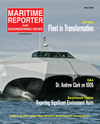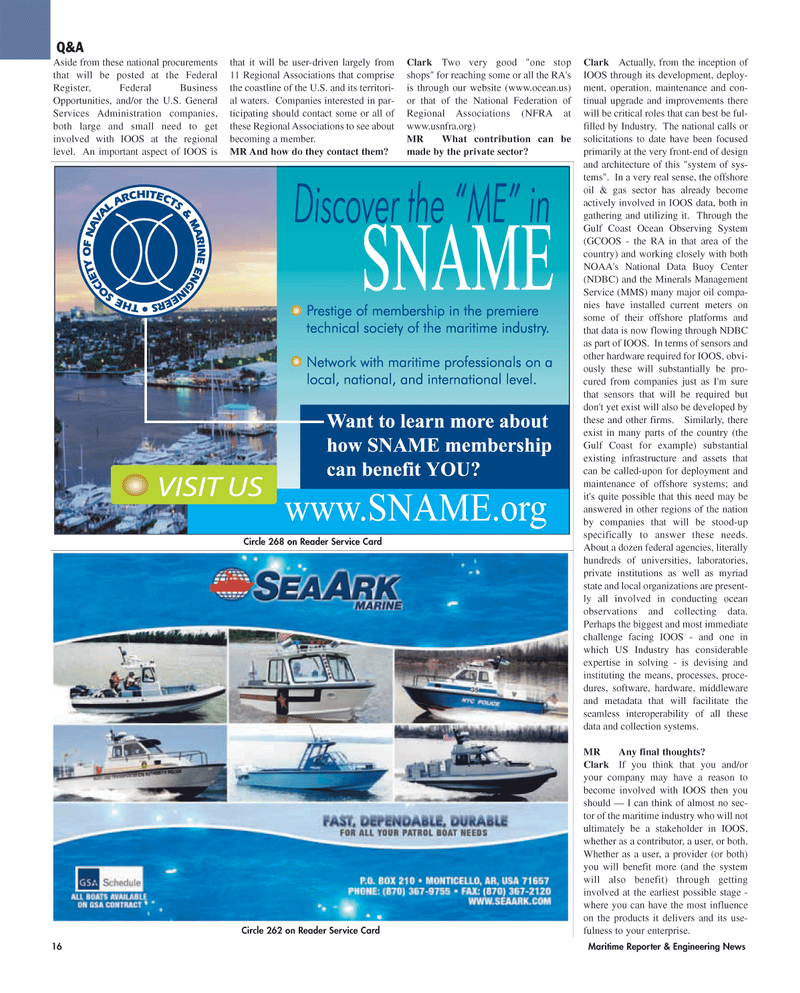
Page 16: of Maritime Reporter Magazine (March 2006)
The Training & Education Edition
Read this page in Pdf, Flash or Html5 edition of March 2006 Maritime Reporter Magazine
16 Maritime Reporter & Engineering News
Aside from these national procurements that will be posted at the Federal
Register, Federal Business
Opportunities, and/or the U.S. General
Services Administration companies, both large and small need to get involved with IOOS at the regional level. An important aspect of IOOS is that it will be user-driven largely from 11 Regional Associations that comprise the coastline of the U.S. and its territori- al waters. Companies interested in par- ticipating should contact some or all of these Regional Associations to see about becoming a member.
MR And how do they contact them?
Clark Two very good "one stop shops" for reaching some or all the RA's is through our website (www.ocean.us) or that of the National Federation of
Regional Associations (NFRA at www.usnfra.org)
MR What contribution can be made by the private sector?
Clark Actually, from the inception of
IOOS through its development, deploy- ment, operation, maintenance and con- tinual upgrade and improvements there will be critical roles that can best be ful- filled by Industry. The national calls or solicitations to date have been focused primarily at the very front-end of design and architecture of this "system of sys- tems". In a very real sense, the offshore oil & gas sector has already become actively involved in IOOS data, both in gathering and utilizing it. Through the
Gulf Coast Ocean Observing System (GCOOS - the RA in that area of the country) and working closely with both
NOAA's National Data Buoy Center (NDBC) and the Minerals Management
Service (MMS) many major oil compa- nies have installed current meters on some of their offshore platforms and that data is now flowing through NDBC as part of IOOS. In terms of sensors and other hardware required for IOOS, obvi- ously these will substantially be pro- cured from companies just as I'm sure that sensors that will be required but don't yet exist will also be developed by these and other firms. Similarly, there exist in many parts of the country (the
Gulf Coast for example) substantial existing infrastructure and assets that can be called-upon for deployment and maintenance of offshore systems; and it's quite possible that this need may be answered in other regions of the nation by companies that will be stood-up specifically to answer these needs.
About a dozen federal agencies, literally hundreds of universities, laboratories, private institutions as well as myriad state and local organizations are present- ly all involved in conducting ocean observations and collecting data.
Perhaps the biggest and most immediate challenge facing IOOS - and one in which US Industry has considerable expertise in solving - is devising and instituting the means, processes, proce- dures, software, hardware, middleware and metadata that will facilitate the seamless interoperability of all these data and collection systems.
MR Any final thoughts?
Clark If you think that you and/or your company may have a reason to become involved with IOOS then you should — I can think of almost no sec- tor of the maritime industry who will not ultimately be a stakeholder in IOOS, whether as a contributor, a user, or both.
Whether as a user, a provider (or both) you will benefit more (and the system will also benefit) through getting involved at the earliest possible stage - where you can have the most influence on the products it delivers and its use- fulness to your enterprise.Circle 262 on Reader Service Card
Circle 268 on Reader Service Card
Q&A
MR MARCH2006 #2 (9-16).qxd 3/2/2006 11:29 AM Page 16

 15
15

 17
17
